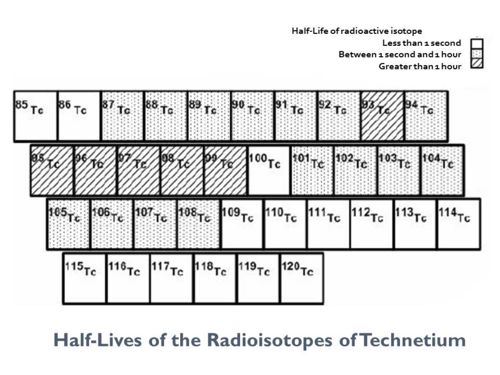Technetium: Difference between revisions
imported>Anthony.Sebastian (elaborate on 'lightest') |
imported>Anthony.Sebastian (→Technetium radioisotope half-lives: add content & citation) |
||
| Line 27: | Line 27: | ||
{{Image|Technetium isotopes-3.jpg|center|500px|}} | {{Image|Technetium isotopes-3.jpg|center|500px|}} | ||
{{-}} | {{-}} | ||
To find the numerical value of the half-life of any isotope of technetium, see:<ref>[http://periodictable.com/Elements/043/data.html Technical data for Technetium]. | |||
*<font face="Gill Sans MT">Scroll down to "Nuclear Properties", find "Known Isotopes", click on symbol for any isotope to see its half-life as well other technical data for that isotope, including decay chains leading to and from the isotope.</font></ref> | |||
==References== | ==References== | ||
<References/> | <References/> | ||
Revision as of 17:46, 26 April 2011
| |||||||||||||||||||||||||||||||||||||||||||||||||||||||||||||||||||||||||||||||||||||||||||||||||||||||||||||||||||||||||||||||||||||||||||||||||||||||||||||||||||||||||||||||||||||||||||||||||||||||
Technetium is a chemical element, having the chemical symbol Tc. Its atomic number (the number of protons) is 43. It has a standard atomic weight of 98.9062 g•mol −1 and is a solid in its elemental form.
Technetium is considered to be a member of the "Transition metal" class of elements.[1] At a pressure of 101.325 kPa, it has a boiling point of 4,265 °C and a melting point of 2,157 °C.
All the isotopes of technetium are radioactive; 98 is the atomic mass of technetium's longest-lived isotope, 98Tc (4.12x106 years).[2] Technetium has the lowest atomic number of the chemical elements that lack a stable isotope.
Only very small amounts of technetium are found in nature.[3] Practically all technetium is produced synthetically as a by-product of the fission of uranium-235 in nuclear reactors and it is extracted from the spent reactor fuel rods.[4]
Technetium radioisotope half-lives
To find the numerical value of the half-life of any isotope of technetium, see:[5]
References
- ↑ Note: Technitium is also sometimes referred to being a member of a Synthetic or Quasi-synthetic class of elements.
- ↑ Technetium Isotope data.
- ↑ Schwochau K. (2000) Technetium: chemistry and radiopharmaceutical applications. Wiley-VCH. ISBN 9783527294961. | Google Books preview.
- See section 3.2 for history of discovery of technetium in Earth's crust.
- ↑ John Elmsley (2001). Nature's Building Blocks: An A-Z Guide to the Elements, 1st Edition. Oxford University Press. ISBN 0-19-850341-5.
- ↑ Technical data for Technetium.
- Scroll down to "Nuclear Properties", find "Known Isotopes", click on symbol for any isotope to see its half-life as well other technical data for that isotope, including decay chains leading to and from the isotope.
